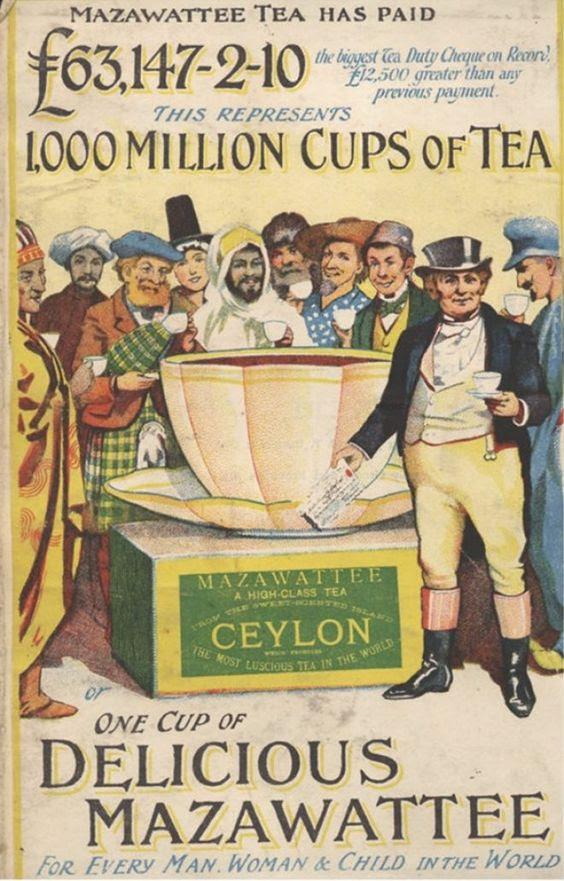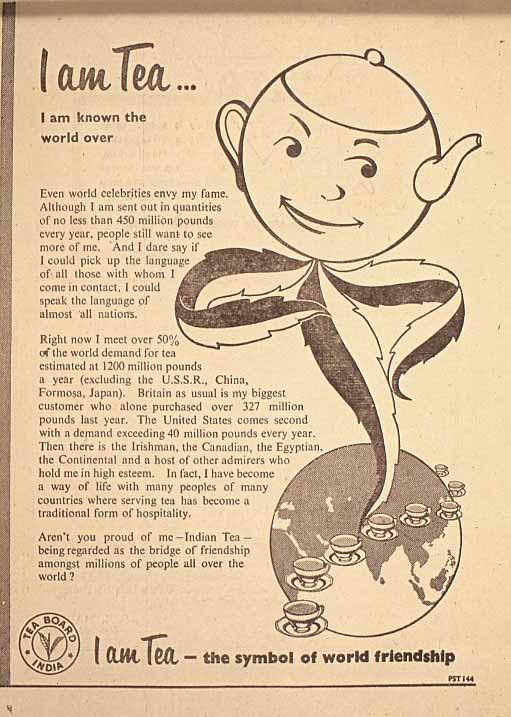Tea and the Imperial Origins of the Modern Consumer
archive


International Tea Market Expansion Board map (1940) by MacDonald Gill.
Tea and the Imperial Origins of the Modern Consumer
Coca-Cola and MacDonald’s often come to mind when we think about globalization. We might also conjure up visions of Nike, Apple, Samsung or any number of other multinational corporations. We are right to do so. These multinationals literally manufacture the material experiences of countless consumers and workers around the world.1 Not all companies and commodities, however, generate the same degree of global recognition on the part of consumers. Consumers’ ignorance about the global sources of their material world makes it especially difficult for political movements that seek to harness buying power to improve such things as working conditions or environmental degradation. As activists well know, it is challenging to inspire consumers to recognize the long term and long-distance effects of their purchases.
Scholars, activists, and corporate marketers alike wrestle with how knowledge informs consumers’ economic and political choices. The way we think and talk about consumers today as either passive or active is a legacy of the cultural and social environments in which merchant and industrial capitalism have developed since at least the seventeenth century. Specifically, the modern idea of the consumer was born within, fashioned by, and shaped the development of European imperialism.
The history of tea particularly illuminates the imperial origins of the modern consumer and provides a context for thinking about the labyrinthine connections between capitalism, politics, and activism. Today, tea is grown in approximately twenty-four countries with China, India, Sri Lanka, and Kenya being the largest producers.2 Advertising and packaging frequently reference the drink’s “exotic” origins and long-distance travels, but just as much publicity has associated tea drinking with privacy, interiority, intimacy, femininity and domesticity.3 Both the global and domestic understandings of the hot brew emerged out of structural transformations in the global tea trade and the advertising industry, and are particularly imprinted with nineteenth and early twentieth-century conceptions of nation and empire, of gender, and of race and class.4 Beliefs about the relationship between men and women, public and private, activity and passivity that were accepted norms in the nineteenth century were built into the very fabric of capitalism.
Unlike sugar, cotton, coffee, and tobacco, tea cultivation did not globalize in the early modern period. The Chinese dominated the production and exportation of tea until ceding control to the British at the very end of the nineteenth century. In the seventeenth and eighteenth centuries, elite European and American consumers enjoyed tea in part because it was foreign, and its "exotic" nature and mysterious origins in China added value and prestige to the expensive brew. Tea was also invariably seen as an Eastern medicine that could cure Western problems. An English broadside from 1690, for example, recommended the "herb that growth in China and Japan," as a means to "preservth in perfect Health till very Old Age."5 Consumers and healers knew very little about tea or China, but they were quite aware that tea was from China and that it could cure any number of ailments from a headache to a lackluster libido.
In the nineteenth-century, however, as relations between China and the West deteriorated, Europeans increasingly saw China as source of disease. The new tea industry established in British-controlled Assam in the 1830s began in part as a response to growing concerns about China and it succeeded by accentuating consumers' fears about consuming Chinese goods. Throughout the middle decades of the nineteenth-century, tea producers and retailers bombarded consumers with stories about the differences between East and South Asia. British producers explained how the tea they produced in India, and later Ceylon, was supervised by European managers and thus was modern and free of the types of unhealthy adulterants found in Chinese-grown tea. Consumers learned a particular story about China, and implicitly, about India, that implied that the safe way to consume global goods was to ensure that Europeans had supervised their production, packaging, and trade. That is, European colonialism made global goods safe and pleasurable.6
The history of tea particularly illuminates the imperial origins of the modern consumer and provides a context for thinking about the labyrinthine connections between capitalism, politics, and activism.
Anti-Chinese advertising, imperial tariffs, shipping, and land and labor laws meant that by 1931, the global tea trade had become “largely a concern of the British Empire.” The commodity had reached one per cent of the value of the total merchandise entering world trade, and as an Imperial Economic Committee report explained:
Over 70 per cent of the tea exported is produced in the Empire, and nearly 70 per cent is consumed by the Empire. Over two-thirds of the entire capital engaged in tea production is provided by the Empire. All the machinery employed in India and Ceylon is of Empire origin, and over 60 per cent of the chests used for the transport of tea are imported from Empire countries.7
However, in 1931 this imperial industry all but collapsed, as global capitalism went into a tailspin. The tea industry cut labor and other costs, supported protectionist policies, and in 1933 entered into an international agreement to curb production. The industry also invested heavily in the creation of global mass markets.

Mazawattee Tea advertisement, circa 1890. "...the biggest Tea Duty Cheque on Record..."
Private companies and planters’ associations sponsored campaigns and nationalistic Buy British/Empire advertising that informed British consumers how shopping for the empire could protect jobs in Assam and Manchester. British tea growers and traders pushed consumers to shop for the Empire, buyers to source from the Empire, and politicians to protect the Empire. Tea advertising asked the consuming pubic to “create a demand for ‘EMPIRE TEA’ and to “obtain protection for such teas in the home market,” to give “active help” to “Empire tea,” by purchasing it when possible, asking for it at the shop, and recommending it to friends.8 Illustrations, in-store displays, exhibitions, and cinema explained that tea was from British India, Ceylon, Southeast Asia, and Africa. Such global knowledge was critical if consumers were to be able to make educated decisions and eschew foreign substitutes, such as Chinese tea.
Within a year or two, however, lackluster support from the big brands, distributors, and consumers led growers and advertisers to question whether it was wise or even possible to appeal to consumer patriotism. By the mid 1930s, tea advertising instead highlighted the bodily and social pleasures of drinking tea and downplayed the commodity’s colonial nature. Such ads sold tea as a domestic beverage rather than an imperial product. This approach was well suited to the increasingly international nature of tea’s production and distribution, fit contemporary notions about how working-class and nonwhite consumers read advertising, and was a reaction to the vocal protests of labor and nationalist activists who were constructing quite negative images of the plantation.

Figure 1: International Tea Market Expansion Poster advertisement, circa 1935. source
In 1935 British producers formed the International Tea Market Expansion Board, a body dedicated to expanding global tea markets. Their “Tea Revives You” campaign, which lasted until 1952, traded upon the idea that consumers were passive, tired, and depressed creatures that needed to be entertained and energized. Everywhere this campaign spread the simple idea that tea comforted and revitalized the body and calmed the mind.9 All consumers became the same in ads depicting tired factory and office workers, housewives and agricultural laborers, university students and school children. Newspaper advertising, posters, billboards, pamphlets, brochures, films, and radio broadcasts told Britons, Europeans, Americans, Africans, and South and Southeast Asians that tea was as a modern drink that would make them feel “vital” and “refreshed” while at work, at play, and at home. Tea became a universal panacea in a pressured modern world (Figure 1). This approach advocated a universal ideal of the consumer and the commodity.
Consumers’ gained knowledge about their bodies and tastes but lost an understanding of geography, production, and politics. Consumers developed brand loyalty and failed to ask or even care about where their tea came from—and more importantly, how it was produced. Whereas tea advertising had once relentlessly celebrated the civilizing and moralizing effects of colonial rule, in the mid-twentieth century it suppressed imperial knowledge, making it nearly impossible for consumers to critique their role in the preservation of imperialism.
Consumers’ gained knowledge about their bodies and tastes but lost an understanding of geography, production, and politics.

'I am Tea...' -- Indian Tea Board advertisement.
Generations of generic advertising, wartime rationing, and the growth and consolidation of the big brands, meant that by the 1960s few British consumers—arguably among the most knowledgeable about tea—knew very little about production or imperial history. A market survey which the international ad agency Ogilvy and Mather conducted in 1965, for example, concluded that, “Informants had only very vague and confused notions about the growing, blending and packing of tea.” While some knew it came from China, India and Ceylon, “most did not know where their own tea came from and did not appear to regard this as important. Several respondents denied “having heard of India or Ceylon tea.”10
No doubt, tea’s history is unique. However, the industry’s response to the Depression illuminates how consumer knowledge and ignorance, just like desire and disgust, have a history. This may seem obvious, but we all too often see the consumer as the tail end of global processes and historical change. Rather than simply assert the power of the consumer, however, we need to recognize that both the powerful and passive consumer are historical and social constructs which were embedded in the development of global economies and cultures and political struggles. Consumer movements are destined to achieve only limited success if their leaders fail to interrogate their own assumptions about what consumers should and should not know about the world.
1. The uneven impact of the global corporation has been approached by economic historians, anthropologists, literary scholars and numerous other disciplines. See, for example, Geoffrey Jones, Multinationals and Global Capitalism from the Nineteenth Century to the Twenty-First Century (Oxford: Oxford University Press, 2005), 295-96. There is a great deal of work on Coca-Cola, which looks at the generative nature of consumption and local political practices. See for example, Bishnupriya Ghosh, “Looking through Coca-Cola: Global Icons and the Popular,” Public Culture 22, no. 2 (2010): 333-368; Daniel Miller, “Coca-Cola: A Black Sweet Drink from Trinidad,” in Material Cultures: Why Some Things Matter, ed. Daniel Miller (Chicago: The University of Chicago Press, 1998) and Robert John Foster, Coca-Globalization: Following Soft Drinks from New York to New Guinea (New York: Palgrave Macmillan, 2008).
2. Kaison Chang, World Tea Production and Trade Current and Future Development (Rome: FAO, 2015), 4.
3. See, for example, the opening of Piya Chatterjee, A Time for Tea: Women, Labor, and Post/Colonial Politics on an Indian Plantation (Durham: Duke University Press, 2001), 3-4.
4. Erika Rappaport A Thirst for Empire: How Tea Shaped the Modern World (Princeton: Princeton University Press, 2017).
5. Samuel Price, The Virtues of Coffee, Chocolette, and Thee or Tea," (London, 1690).
6. Rappaport, A Thirst for Empire, chapter four.
7. Imperial Economic Committee Report on Tea (1 June 1931), 1. NA C0 323/1142/18.
8. “EMPIRE GROWN TEA.” 1931, BL MSS Eur F 174/854, Indian Tea Association Collection (ITA).
9. Report of the International Tea Market Expansion Board (1936), 9. BL Eur. MSS F174/961, ITA.
10. Ibid.



